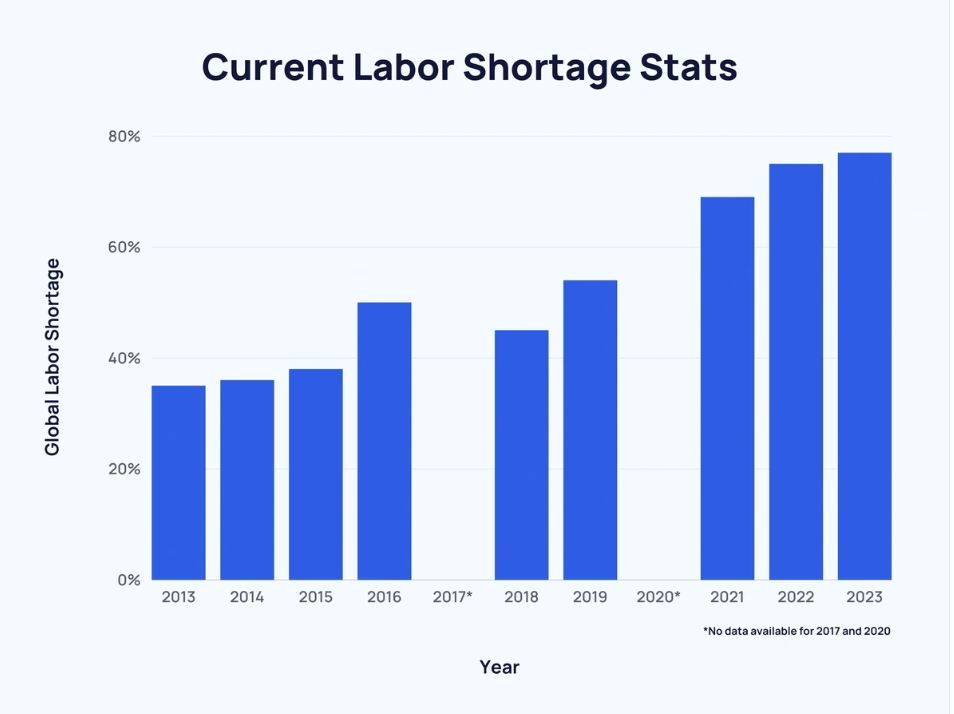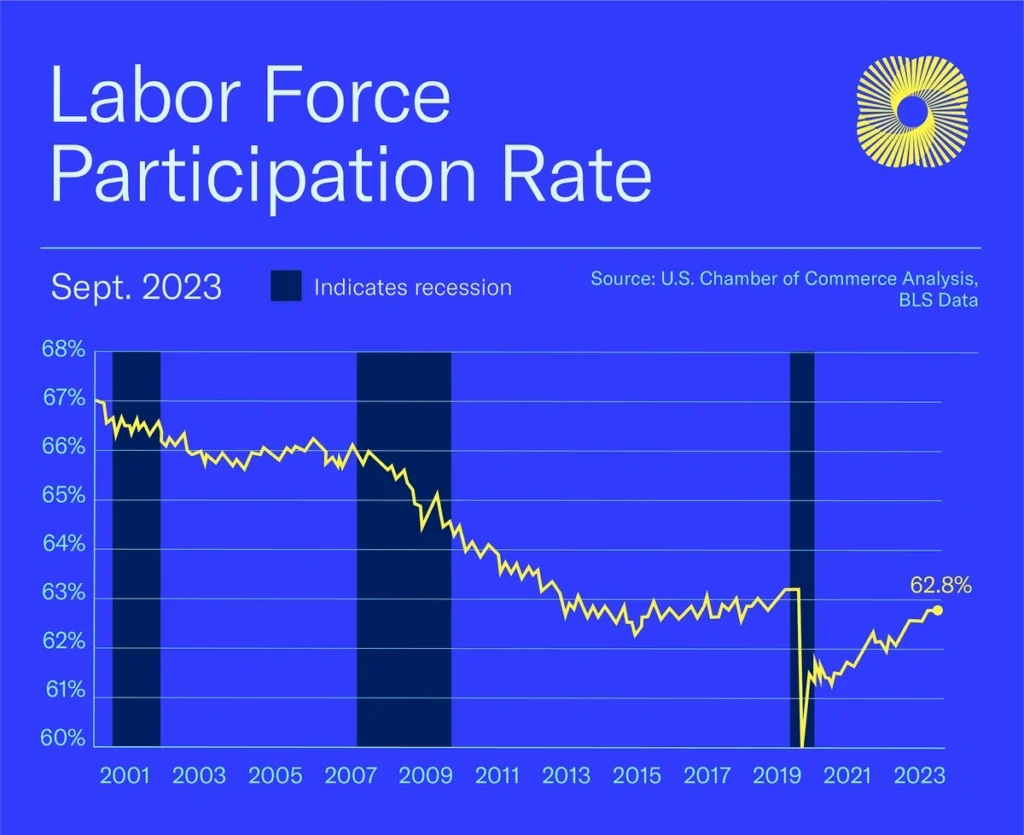Seasoned and new project managers both understand the importance of efficient planning and effective construction crew management for project success. From breaking ground to putting the finishing touches, every phase of construction demands meticulous organization and coordination.
Construction industry is set for tremendous growth. In 2023, construction expenditure in the United States surpassed $2.1 billion.

The estimated size of the North American Construction Market in 2024 stands at USD 2.46 trillion, with projections indicating a growth to USD 3.11 trillion by 2029. This growth is expected to occur at a compound annual growth rate (CAGR) of 4.82% over the 2024-2029 forecast period.
Construction managers need to stay updated with the ever-evolving industry trends and market details to make informed decisions. For example, the rise in demand for green buildings and sustainable practices presents opportunities for construction managers to implement environmentally friendly solutions, such as using energy-efficient materials and technologies.
Major Crew Management Challenges
Crew management in construction projects presents various challenges that require proactive measures. Managers must be prepared to address common challenges such as skill gaps, schedule conflicts etc.
A significant challenge grappling the entire industry is labor shortage.

Source: https://explodingtopics.com/blog/labor-shortage-stats
According to ManpowerGroup, nearly 77% of employers are facing challenges in filling job vacancies, marking the highest recorded figure since surveys commenced in 2006.
Furthermore, the number of employers reporting labor shortages has more than doubled since 2015, increasing from 38%.
Identifying labor shortages in the construction industry involves a systematic analysis of workforce supply and demand dynamics within specific geographical regions and sectors. Since February 2020, US alone has lost as many as 1.4 million workers from the labor force.

Source: US Chamber of Commerce Analysis, BLS Data
Many factors cause this phenomenon. Some of them are-
Aging population: As the population ages, a significant portion of experienced and skilled construction workers reaches retirement age. This demographic shift results in a substantial loss of knowledge and expertise from the workforce, leading to a shortage of experienced workers who are capable of handling complex construction projects.
Surveys and Interviews: Conducting surveys and interviews with construction firms, labor unions, trade associations, and educational institutions to gather insights into current and projected labor needs, skill requirements, recruitment challenges, and training initiatives.
Industry Reports and Forecasts: Reviewing industry reports, forecasts, and analyses from construction trade associations, research firms, and government agencies can provide valuable insights into labor market trends, including potential shortages.
Moreover, construction managers should invest in continuous skill development programs to bridge any skill gaps among their crew members.
Furthermore, construction managers must also leverage new tools and software into their crew’s workflow to stay ahead of competition.

Embracing innovations such as asset management, advanced time tracking and mobile inspections can streamline processes, enhance collaboration, and improve overall project efficiency. Training sessions and workshops on these technologies should be conducted regularly to ensure that crew members are up-to-date and proficient in using them effectively.
Moreover, fostering a positive and inclusive work culture within the crew is essential for maintaining high morale and productivity. By identifying employee burnout by keeping a track of overtime worked and compensating fairly, every crew member feels valued and motivated. By prioritizing both technical skills development and team cohesion, construction managers can effectively address crew challenges and drive successful project outcomes
Importance of Strategically Planning a Construction Crew
Strategic crew planning is crucial for effectively managing construction projects. Proper crew planning involves determining the required skills and resources for each phase of the project. By assigning crew members based on their expertise, construction managers can maximize efficiency, reduce costs, and minimize delays.
For example, let’s consider a commercial construction project where the excavation phase requires skilled equipment operators. A construction manager who strategically plans the crew by assigning experienced equipment operators to this phase ensures smooth execution and timely completion of the excavation tasks.
Asset tracking using QR code streamlines the process further. Each piece of equipment is assigned a unique QR code using a QR code generator. It contains details like equipment type and maintenance history. Workers scan these codes with the allGeo app to access information and update maintenance records, ensuring efficient operations and safety compliance across job sites.
Using a scheduling app, crew members can be easily assigned tasks that align with their skills and experience. This decreases the likelihood of accidents and errors significantly. For instance, in a high-rise construction project, assigning trained workers for working at heights can prevent potential safety hazards and ensure compliance with regulations.
Planning Tasks and Scheduling For Construction Crew Members
1. Breaking-up Tasks:
Planning tasks and scheduling are foundational aspects of construction project management. These processes involve breaking down the project into smaller, manageable tasks and creating detailed schedules. This approach allows construction managers to efficiently allocate resources, establish realistic timelines, and identify potential scheduling conflicts. For example, in a residential construction project with multiple subcontractors, effective task planning and scheduling enable the coordination of subcontractor activities to ensure synchronization and avoid delays or conflicts.
2. Risk Management:
Proper planning and scheduling in construction also serve as essential tools for risk management. With a detailed schedule in place, project managers can anticipate potential risks and plan mitigation strategies accordingly. For instance, if there’s a delay in material delivery, a well-planned schedule allows for adjustments in timelines and resource allocation to minimize the impact on the overall project timeline. This proactive approach to risk management can save time and costs for the construction project.
3. Communication and Collaboration:
Effective task planning and scheduling contribute to improved communication among project stakeholders. When all team members have a clear understanding of the project schedule and task dependencies, it fosters better collaboration and coordination. Enhanced communication ensures that everyone is aligned with project objectives, deadlines, and expectations, leading to smoother project execution and successful outcomes.

The 5 Phases of Project Management
Construction projects typically follow five key phases. Although it may differ depending on the size and scale of the project and company, each phase has its specific challenges. The use of automation software can greatly streamline project management processes, leading to improved efficiency and accuracy.
Phase 1: Project Initiation and Conception
In this phase, construction managers define the project’s objectives, assess its feasibility, and identify potential risks. This could involve a construction manager planning a new hospital project, for instance. During the initiation and conception phase, the construction manager conducts thorough research, establishes the project’s scope, and collaborates with stakeholders to ensure the project aligns with the overall vision and goals.
Furthermore, in the initiation stage, the construction manager may also conduct site visits with employees to assess the location’s suitability for the project. It is during this phase that you must introduce the automation app that employees will be using so that there is enough time for them to get used to it. Due to the frequent visits, the mileage tracking feature of the app will be beneficial to keep track of costs in this phase.
Factors such as accessibility, environmental impact, and zoning regulations are carefully evaluated to determine the best course of action. This phase sets the foundation for the entire project, laying the groundwork for future decision-making and planning.
Phase 2: Project Planning and Procurement
This phase involves delineating the project scope, conducting feasibility studies, and estimating costs to establish a viable budget. Additionally, it entails formulating procurement strategies, selecting vendors through competitive bidding or negotiations, and drafting contracts. Efficient resource planning and scheduling are paramount during this phase to ensure that projects are executed on time, within budget, and to the highest standards of quality and safety.
During the project procurement phase, freight broker tracking feature can play a crucial role.
With real-time load tracking, you can get on-demand location updates and ETA predictions. Automatic exception alerts promptly notify you of any delays or stoppages, enabling swift action to mitigate disruptions. Additionally, a smart dispatching solution optimizes scheduling, routing, and dispatch operations, ensuring drivers receive optimal routes via the mobile app.
Further, an automation software can also help cost-effectively monitor critical events in your freight operations cost effectively.
Another crucial aspect of the planning and procurement phase in a large-scale commercial construction project is conducting thorough risk assessments. Construction crew managers must identify potential risks such as inclement weather, supply chain disruptions, or labor shortages that could impact the project timeline and budget.

Phase 3: Project Execution
During the execution phase, construction managers oversee the physical construction activities, manage the crew, and coordinate with subcontractors and suppliers. Effective communication, efficient resource allocation, and continuous monitoring are essential for successful project execution.
Construction managers also play a crucial role in ensuring that all safety protocols and regulations are strictly adhered to on the construction site. While regular safety inspections and training for workers are required, a lone worker safety app is another robust solution.
Additionally, project execution involves managing the project schedule to ensure timely completion within budget constraints. Construction crew managers create detailed construction schedules, monitor progress against milestones, and make adjustments as needed to keep the project on track. They also handle unexpected delays or changes in plans by reorganizing resources and coordinating with stakeholders to minimize disruptions and maintain project efficiency.
Phase 4: Project Performance
Project performance involves monitoring the project’s progress, ensuring quality control, and managing any deviations from the original plan. For instance, a construction crew manager may analyze the project’s performance by comparing the actual progress against the planned schedule. Generating custom reports helps easily identify bottlenecks and take corrective actions to improve project performance.
Schedule variance is a vital KPI that measures the difference between the planned job schedules and the actual progress made.
Phase 5: Project Closeout Phase
The project closeout phase involves completing final inspections, addressing any outstanding issues, and delivering the finished project to the client. Construction managers play a crucial role in ensuring that all contractual obligations are met, conducting final walkthroughs, and obtaining necessary sign-offs.
During the final inspections, construction managers meticulously review all aspects of the project to ensure compliance with building codes, safety regulations, and quality standards.
Furthermore, the project closeout phase involves documenting all project activities, including any changes, challenges faced, and lessons learned throughout the construction process. The time tracking app will provide data into any overtime costs that you may need to add.
Capturing field data using inspection forms or mobile forms helps manage all the data in the cloud, which is easily accessible anywhere. This documentation serves as a valuable resource for future projects, allowing construction managers to identify areas for improvement and implement best practices.
By capturing this information in a comprehensive project closeout report, construction managers can enhance their project management processes and deliver even better results in subsequent endeavors.
Best Practices for Managing Construction Crew During Projects
1. Ensure Workers Understand Project Expectations
Clear communication is key to effectively managing a construction crew. Construction managers must ensure that workers fully understand the project expectations, their roles, and responsibilities. By providing detailed instructions and conducting regular meetings, construction managers can foster a cohesive working environment. For example, a construction manager may hold daily toolbox talks to review project goals, reinforce safety protocols, and address any concerns raised by the crew members.
2. Adequate Training for Using Mobile Apps
In today’s digital age, mobile apps can significantly enhance construction crew management. Construction managers should provide adequate training to the workforce on using mobile apps relevant to the project, such as construction management software time tracking, job scheduling, mileage tracking etc. For instance, a construction manager may train the crew on using a mobile app that allows them to login via time tracking app, access job details, projects docs etc. This streamlines communication, improves efficiency and reduces paperwork.
3. Safe Working Environment
Creating a safe working environment is paramount in construction crew management. Construction managers must implement and enforce strict safety protocols to protect the crew members from injuries and accidents. For example, a construction manager may conduct regular safety inspections, provide personal protective equipment (PPE), and conduct safety training sessions. Furthermore, a threat escalation workflow triggers notifications or alarms based on customized events/exceptions or IFTTT (If-this-then-that) rules engine.
4. Automate Using a Geofence Time Clock App
Accurately tracking the working hours of construction crew members is crucial for payroll management and productivity assessment. Construction managers can leverage geofencing technology to automate time tracking. Geofencing uses GPS to create virtual boundaries, allowing construction managers to monitor when crew members enter or exit job sites. By automating time tracking, construction managers eliminate manual errors, reduce administrative burdens, and ensure fair compensation for the crew members.
5. Real-time View (Transparency for Both Managers and Field Employees)
Transparency is key to effective construction crew management. Construction managers can utilize software platforms that provide real-time project data, allowing them and field employees to access critical information anytime, anywhere. For example, an integrated construction management platform enables construction managers to monitor project progress, review updated schedules, and track on-field activity. Simultaneously, field employees can access important project documents, receive immediate updates, and report issues directly through the platform, enhancing collaboration and decision-making.
7. Effective Schedule Conflict Resolution
Construction projects often involve various stakeholders, including crew members, subcontractors, and clients. Construction managers must have effective schedule conflict resolution strategies in place to address any issues that may arise. By adopting a job schedule software, construction managers can resolve scheduling conflicts in a timely and fair manner. This fosters a positive work environment, improves team morale, and ensures project success.
Conclusion
Effective construction crew planning and management are instrumental in achieving project success. By strategically planning tasks and crew assignments, staying informed about market trends, and leveraging field automation tools, construction managers can streamline processes, enhance productivity, and deliver high-quality construction projects.
Incorporating best practices such as clear communication, adequate training, maintaining a safe working environment, automating time tracking, and promoting job schedule transparency can further contribute to construction crew management success. Implementing these strategies and practices equips construction managers with the knowledge and tools necessary to navigate the complexities of construction projects and meet the ever-evolving demands of the industry.



